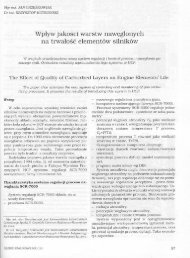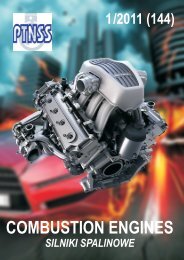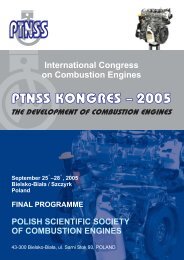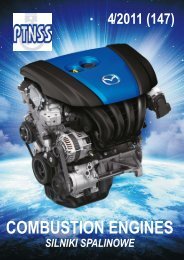Create successful ePaper yourself
Turn your PDF publications into a flip-book with our unique Google optimized e-Paper software.
A simulation study of turbocharger intake leakage on its efficiency<br />
a)<br />
b)<br />
Fig. 4. Test stand: a – direction of the incoming hot gases, b – outlet direction of the gases,<br />
c – direction of the incoming compressed air, d – outlet direction of the compressed air<br />
Rys. 4. Stanowisko badawcze: a – kierunek dolotu gorących spalin, b – kierunek wylotu spalin,<br />
c – kierunek dolotu powietrza sprężanego, d – kierunek wylotu powietrza sprężonego<br />
Fig. 5. Research equipment: a) stereoscopic<br />
microscope MOTIC SMZ 168, b) digital camera<br />
MOTICAM 2000 [7]<br />
Rys. 5. Aparatura badawcza: a) mikroskop stereoskopowy<br />
MOTIC SMZ 168, b) kamera cyfrowa<br />
MOTICAM 2000 [7]<br />
Fig. 6. The damage-initiating element placed in the intake section<br />
(f 1<br />
= 10 mm, f 2<br />
= 14 mm)<br />
Rys. 6. Element inicjujący uszkodzenia umieszczony w układzie dolotowym<br />
(f 1<br />
= 10 mm, f 2<br />
= 14 mm)<br />
The turbocharger shaft was revved up to the speed of<br />
approximately 60,000 rpm and then in the intake duct the<br />
damage-initiating element was placed. Hence, a controlled<br />
damage of the assembly was realized. The operation of<br />
the damaged turbocharger resulted in further damage until<br />
permanent failure. After the trial an analysis of the damage<br />
described in subchapter 3.3 was carried out.<br />
3.3. Damage analysis<br />
After the tests were conducted the turbocharger was disassembled<br />
into separate parts. The primary cause of damage<br />
was the destroyed compressor impeller (Fig. 7).<br />
The damage to the vanes and the resulting modification<br />
of the geometrical parameters of the compressor impeller<br />
led to an unbalancing caused by a divergence of the axis of<br />
asymmetry with the main axis of inertia in the turbine–shaft–<br />
compressor assembly, which resulted in an snowball damage<br />
of the components. The nature of the damage progression is<br />
rozmiarów (rys. 6).<br />
Wał turbosprężarki rozpędzono do prędkości ok. 60 000<br />
obr/min, a następnie w układzie dolotowym umieszczono<br />
element inicjujący. W ten sposób dokonano kontrolowanego<br />
uszkodzenia podzespołu. Eksploatacja uszkodzonej<br />
takim sposobem turbosprężarki generowała dalsze zniszczenia,<br />
prowadząc do całkowitej dysfunkcji. Po przeprowadzonym<br />
badaniu dokonano analizy uszkodzeń opisanych<br />
w punkcie 3.3.<br />
3.3. Analiza uszkodzeń<br />
Po przeprowadzonych badaniach zdemontowano turbosprężarkę<br />
oraz rozebrano ją na części. Pierwotną przyczyną<br />
uszkodzeń był zniszczony wirnik sprężarki (rys. 7).<br />
Uszkodzenie łopatek i wynikająca z tego zmiana parametrów<br />
geometrycznych wirnika sprężarki spowodowały<br />
niewyważenie, polegające na niezgodności osi symetrii z<br />
główną osią bezwładności układu turbina–wał–sprężarka,<br />
co w następstwie powoduje uszkodzenia o charakterze<br />
lawinowym. Charakter postępowania zniszczeń nie jest<br />
Fig. 7. Damage compressor impeller<br />
Rys. 7. Uszkodzony wirnik sprężarki<br />
<strong>COMBUSTION</strong> <strong>ENGINES</strong>, No. 4/2012 (151)<br />
67












